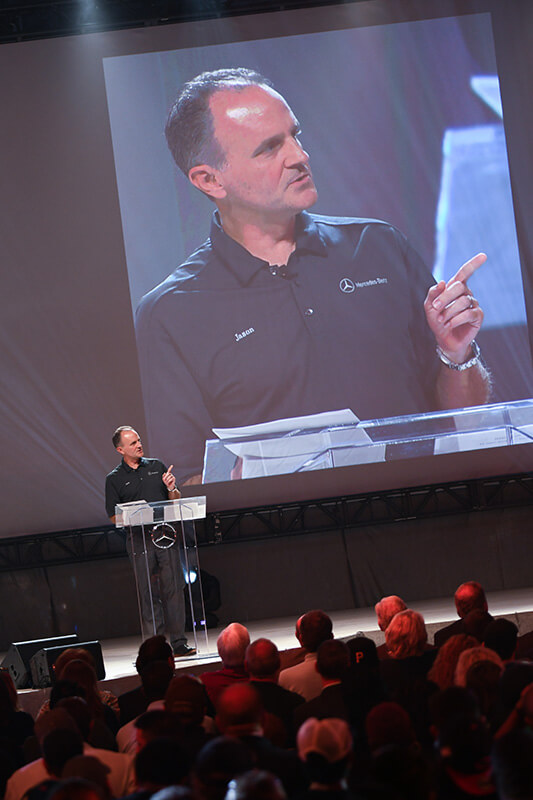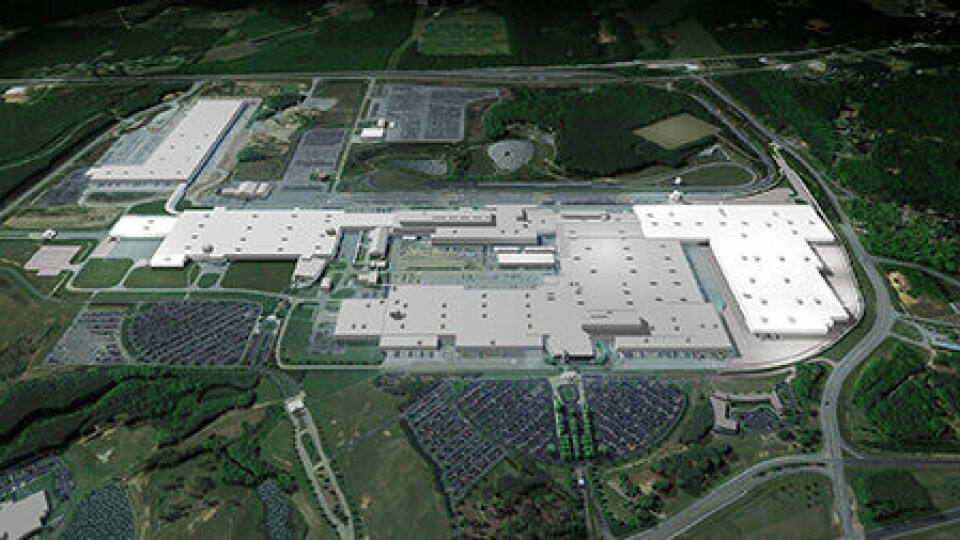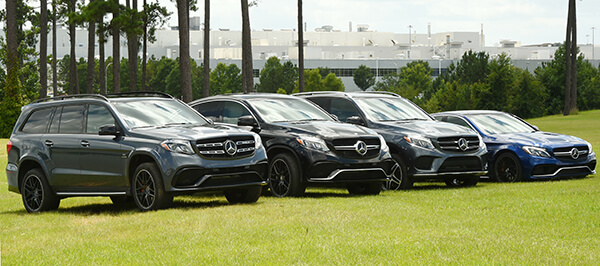MBUSI: In a state of contentment
 Why has Alabama become such a mecca for automotive manufacturing?I think there are a number of reasons. You have seen the automotive industry continue to push further south into areas where there is a good workforce available. You have infrastructure that is available. The supplier network has continued to migrate further south. You are seeing OEMs that offer the best possible infrastructure, workforce and network. That’s what’s driving a lot of it.
Why has Alabama become such a mecca for automotive manufacturing?I think there are a number of reasons. You have seen the automotive industry continue to push further south into areas where there is a good workforce available. You have infrastructure that is available. The supplier network has continued to migrate further south. You are seeing OEMs that offer the best possible infrastructure, workforce and network. That’s what’s driving a lot of it.
Alabama has certainly offered Toyota-Mazda an attractive site for them. I think it’s an area where they feel they can get a good workforce – both out of Alabama and Tennessee.
How has the supply chain/supplier network evolved over the years in the state of Alabama and in the south-eastern US? And how has the growth of the supplier network benefitted OEM plants?I don’t know that I would say it has promoted the companies coming further south, but it’s not seen as a hindrance any more. A lot of suppliers are willing to launch new locations near these operations, especially those who provide just-in-sequence components. We see that here, in our area. Sometimes, business has moved from one supplier to another as we change our vehicles from one lifecycle to another.
Suppliers are more than willing to invest in new locations and new operations, if they feel it’s a good business case. A lot of the business is still tied to lifecycles of vehicles – not always, but in many cases. It’s a fairly mid-term commitment in that they know they are going to have a certain amount of time where they are going to be able to recoup their investment.
Obviously, you have suppliers who have a stronger presence in the southern states. It’s not like all their operations are up in the north and they are starting up a plant for the first time in the south. Most of them have operations in place in the south, and maybe it’s just a matter of starting up a new plant.
We are also seeing suppliers who are near our operation who have expanded their customer base. When you go and visit them, you notice that there are a lot of other customers in there. They may have come here for us to begin with, and that might have been what initiated a new operation or new plant, but they are aggressively pursuing other business. And now, as more OEMs locate down here, they [the suppliers] are able to say they have a plant down here. Maybe they need to expand the plant. Maybe they are losing some business with one OEM, so they have open space, and so on. I do think that is supporting a stronger supply base down here.
[related_topics align="right" border="yes"]Have improvements in efficiency at the plants, in terms of holding less inventory on site, driven some of the changes we are seeing within the automotive supply chain?You are definitely seeing suppliers who have their main manufacturing operation in a central location here in the south-east but are also working with logistics service providers who are next to the plant. That’s a trend that we are clearly seeing. They don’t want to have to build multiple locations with heavy equipment investments where you have to do injection moulding and those types of things.
What we are seeing in many cases is suppliers have one to two core locations where they are doing the manufacturing that requires the higher investment, but being smarter and utilising logistics service providers near the operations to be able to exactly support some of those logistics requirements that the OEMs are giving them.
When we started 20 years ago a lot of our suppliers built their plants just for us. I can remember visiting a lot of our supplier operations that were just for us. When you go into those operations today, you don’t see that any more. Rarely ever do you see a plant that is solely dedicated to just one OEM.
With some of the new suppliers that we are taking on for our next generation of vehicles, they are following that model, where they may have a larger manufacturing operation – not necessarily in the state or within a 30-40-mile radius of us – and they have a larger logistics service provider next to the plant or near the plant. They can also store a little more inventory or have a bit of a buffer, and they can still meet the logistics requirements that we have placed on them.

Suppliers around MBUSI’s Tuscaloosa site have grown and are expanding further to meet demand from other OEMs, such as Toyota and Mazda at their upcoming plant in Huntsville
How do you handle inventory onsite and how has that changed over the years?We separate our inventory into two groupings. We do get some components out of Europe. Obviously, the inventory level on those components is higher than for those based out of Nafta. On the Nafta materials, we have significantly reduced the amount of inventory that we were holding on site. Some of that has been converted into sequence or just-in-time-type deliveries.
Even with the stuff coming out of Europe, we are getting smarter and not using onsite space as much, but external locations where we can hold things and then pull them in as needed. This is done at a significantly reduced cost.
In 2014, we built an onsite logistics centre that now houses the bulk of our onsite inventory. That logistics centre is even linked through a tunnel to the larger of our two assembly operations. We clearly saw benefits and economies of scale by being able to bring commodities on site and being able to transport them in a much shorter time and, in some cases, without even a truck, directly into the assembly shop.
Can you say more about the logistics centre and the change it represents in the traditional production model?It has presented us with a lot of opportunities. As I said, we use the tunnel to transport some of the bigger commodities directly into the plant. We can use a driverless tugger to bring the commodities through. You won’t find any people in the tunnel. Everything that is transported through it is via driverless or guided vehicles. They are basically tuggers that follow a track in the floor.
What we are trying to do in that process is utilise that tunnel to its maximum. It’s a question of how much traffic we can get in there without impacting our operations or causing traffic jams.
[mpu_ad]From the way you have described the logistics centre and the tunnel system, it would appear to provide the potential for greater efficiencies in relation to critical considerations like sequencing and use of space. Is that the case?Certainly, we build very complex vehicles here. We sell our vehicles in 130 different countries. So, the complexity we see in our operation continues to grow. One of the things that is important to us is how to present parts to the line in a way that reduces the complexity for the team member who has to pick the part and install it in the vehicle. And when you have an operation like a logistics centre, you can move some of those critical things in there to be able to quickly get them to the shopfloor.
How did you go about setting up your supplier park?We have worked very closely with the state of Alabama over the years, and we now have two main supplier parks within a ten-mile radius of the plant. We also have a third one that was recently opened that is also about ten miles down the road. We’ve been fortunate in working with the state. They helped to establish supplier parks very close to us and that’s where the majority of our just-in-sequence suppliers have located.
Can you say more about your plans for the new battery plant related to your electronic vehicle initiative?We haven’t decided what the final location will be. It is planned to be owned and operated by Mercedes-Benz and by our operation here. Hopefully, we’ll decide the final location in the first half of this year and then start the groundbreaking and begin work on that plant. But it will be part of our operation here.
How will the production of your electric line of cars impact on the supply chain?A lot of the supply chain around here will be competing for the electric vehicles. You still need a body. You still need the interior of the vehicle. You need seats in it. You need a cockpit. A lot of things that you have in a vehicle, you are still going to need.
The biggest transformation is on the powertrain side of things. The electric drivetrain – from the battery to the wheels – is going to be a new component. So, it will open up some new opportunities for newer suppliers – if not at tier one level, then at tier two and tier three. You are already seeing suppliers work in that area and compete heavily in that area, as they see the same transformation going on at their operation.
If they are a producer of drivetrain components for traditional, gas-powered engines, they also see the business is changing and they need change with it. We also have to remember it’s still a car, and the vast majority of the car is going to require similar components. So, a lot of those same suppliers are going to compete for that business.
 Mercedes has stated that electric as well as combustion vehicles will be produced at Tuscaloosa in the future. although a location for battery production has yet to be announced
Mercedes has stated that electric as well as combustion vehicles will be produced at Tuscaloosa in the future. although a location for battery production has yet to be announcedAs you look at bringing EV production online, what are the challenges ahead?The EV is going to be a challenge, in that our strategy in all our plants worldwide is to build EVs alongside our traditional internal combustion vehicles. Looking at the lines right now, where we would have an internal combustion SUV, we will have an EV SUV running along right beside it. There are some significant complexity hurdles that we have to work our way through and a lot of work is already happening. For flexibility purposes, we see that as the key to our operational strategy.
“I don’t know that anyone knows or has a really good feeling for how many EVs we are going to be selling in the future – if it’s going to be 10% of our sales or 90%. That’s what we are all wondering. That, from an operational standpoint, drives us to questions like how to make our operations as flexible as possible, so that regardless of what demand comes, we are prepared for it.
What makes the EV market attractive to MBUSI right now?There are number of factors that are driving it. One is, first and foremost, customer taste. We build and sell cars, and customers are desiring an electric vehicle. That’s something that we need to consider and put into our portfolio of vehicles. We are seeing this in the US and a lot of other countries.
Due to CO2 emissions and other factors, countries around the world are really beginning to push and to promote electric vehicles. It’s to the point in some places that you have cities that have said that, as of a certain year, internal combustion vehicles are no longer going to be allowed. From a regulatory standpoint, you are also seeing a lot of pressure being put to expand the offerings of electric vehicles and also the sales of electric vehicles.
Both of those factors combined are driving us to say that this is a market we need to be working our way into. It’s also about the general future of mobility. There are a lot of changes going on in the marketplace for vehicles. The electric vehicle is just one factor among many that we are seeing change in the marketplace.
What does it mean to your operation to have MBUSI choose the Tuscaloosa plant as the starting point for the EV line?We were very excited about the decision and the announcement last year. It’s a great step towards our future. Last year, we were celebrating 20 years of building cars here in Alabama and now we are looking ahead at what the next 20 years will bring.
From our standpoint, it’s a good feeling to have. It’s good to know that we have our feet in both areas – in the traditional internal combustion SUV business and in the future with the electric SUV.
 In 2017, MBUSI celebrated 20 years of manufacturing in Alabama
In 2017, MBUSI celebrated 20 years of manufacturing in AlabamaHow do you feel about being based in Alabama over the last two decades and about the state’s approach towards OEMs, given the new Toyota-Mazda plant?It’s a good place to do business and we are very excited about the future. The new Toyota-Mazda plant is going to bring its set of challenges from the workforce and other areas, but, so far, our work and cooperation with the state has been great and I’m sure it’s going to continue.
Geographically, the state has done a good job of positioning the different OEMs in different areas where we are not competing for labour and team members on a day-to-day basis. I look at it [the Toyota-Mazda plant] as an opportunity for the state and the whole region to try to promote automotive business down here.
Once the [new] plant gets up and running – whatever their volume ends up being – it’s going to propel Alabama into another area as one of the top [automotive] producing states in the US. Hopefully, that will attract more people to consider relocating here.
"I don’t know that anyone knows or has a really good feeling for how many EVs we are going to be selling in the future – if it’s going to be 10% of our sales or 90%. That’s what we are all wondering. That, from an operational standpoint, drives us to questions like how to make our operations as flexible as possible, so that regardless of what demand comes, we are prepared for it." - Jason Hoff, MBUSI





